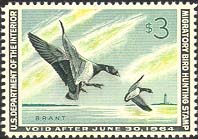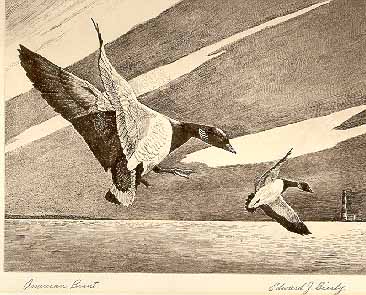

Back to RW30 Back to the Federal Index Home
A LITTLE HISTORY ON THE 30TH (1963-64) DUCK STAMP ARTIST


After being called twice to serve in the armed forces, and after a period of working as a camouflage designer to support his growing family, Edward J. Bierly took the whole family and made a final move to Lorton, Virginia. Since then, Mr. Bierly has been the winner of the Duck Stamp contest a second time. The second painting was one of Brant and demonstrated the same beautiful simplicity that won Mr. Bierly his first Duck Stamp competition. In both paintings, the birds have an almost oriental feel that is actually very difficult to achieve, but which Mr. Bierly makes look easy.
The Bierly's home in Lorton is in an area of rolling, wooded land that is blocked on all sides by superhighways. This is a convenience for Mr. Bierly, who has to get to his work in Washington, and for Mrs. Bierly, who is a substitute teacher in the local schools. Visitors, however, can spend a dizzy two hours trapped in the huge cloverleafs before finding the lovely country road that leads them to the Bierly's charming home. The house is perched on a grassy knoll and surrounded by 25 acres of woods. It is beautifully designed. Some windows look directly out into surrounding trees while others offer a view of the pond some 50 feet straight down at the bottom of a steep ravine. The home's spaciousness and sense of peace soon changed. Within six years, the family included two boys, two girls, and a part Collie dog called Pal. Pal was living on the site when the Bierlys came to build their house. The dog was the first one to make them welcome. The have belonged to him ever since.
Edward Bierly has always preferred painting animals to painting birds. In fact, he has taken several trips to Africa to fulfill commissions by painting animals in their natural environments. Judging by his success in the Duck Stamp competition, no one would ever deny that he's a bird artist, too.
As many artists do, when they finally develop their skills professionally, Mr. Bierly settled on one medium for the bulk of his work. His choice was oil, a medium in which he was successful and comfortable. Despite his specialization, he still was able to function admirably in other media. He was extremely competent when using designer's colors and polymers and was also able to make his own plates for his many etchings.
An acid test of whether or not a painter can maintain his color values is a black-and-white photograph of a color painting. this means that the dark and light tones in the paining have the proper relationship to each other regardless of hue. The ability to determine values is as crucial to an artist as drawing ability or color control. Looking at a black-and-white snapshot of one of his paintings, it is obvious that Mr. Bierly has mastered his craft.
-------------------------THE ART-------------------------
American Brant was painted in gouache. A steel-faced etching aquatint print
was hand pulled on white rives paper using warm black ink. The prints are hand
signed in pencil but not numbered. The image size of the print is 7" x
9". This is Edward Bierly's second design win..
-------------------------THE STAMP-------------------------
American Brant...Engraved by the Federal Bureau of Engraving from the original
artwork. Printed in pale blue, moderate orange-yellow, and black ink. The
stamp sold for three dollars. Postal records show 1,455,486 stamps sold. First
day of sale was July 1, 1963.
Most of the information contained above is from the book Federal Duck Stamp Story, Fifty Years of Excellence, by Laurence F. Jonson; Alexander & Co. It is used here with permission from the author. For more information on this book, please click here.